Photoinitiator Selection and Concentration in Photopolymer Formulations towards Large-Format Additive Manufacturing
Abstract
1. Introduction
- 1
- Low optical density is a strategy which intentionally reduces the absorbance of the photoinitiating system to allow greater light penetration [28]. Per the Beer–Lambert Law, this can be achieved by reducing PI concentration, selecting a PI with low molar absorptivity in the emission region of the light source, or a combination of the two. This approach was successfully employed to cure a methacrylate system up to 31 cm in depth under a 1.1 W/cm2 UV LED light source at 405 nm output [29]. For low optical density to be effective, it is necessary to achieve an optimal PI concentration that allows greater light penetration without being too low for effective curing. This will vary depending on factors such as PI, light source, monomer, fillers, and desired depth of cure [43].
- 2
- Photobleaching is another common method for improving depth of cure in photopolymers [13,27,28,32,44,45,46]. Conventional, non-photobleaching Type I PIs continue absorbing light after reacting, restricting light penetration throughout the curing reaction [27,41]. By contrast, photobleaching PIs have UV-transparent reaction byproducts, allow deeper light penetration into the polymer as the PI reacts. In a process known as photofrontal polymerization, the dynamic light penetration under continuous UV irradiation spurs a free-radical-initiation wavefront [47,48,49,50] that has been shown to allow cure depths of 52 mm [43]. Photopolymers for dentistry regularly incorporate photobleaching PIs to achieve a depth of cure as high as 6 mm in filled systems [32], and novel photobleaching PIs are actively being developed with improved reactivity in the visible/near UV light range typically utilized by dentists [51,52,53]. Since their reaction byproducts are optically transparent, photobleaching PIs are also advantageous for aesthetically critical applications such as gel coats and photocuring inks [27]. Some photobleaching PIs such as BAPO are particularly efficient in the UVA region, making them useful in applications such as stereolithography (SLA) and digital light projection (DLP) [54,55,56,57] that do not require significant depth of cure.
- 3
- Upconversion particles are specialized nanoparticles that absorb light at a higher wavelength (such as NIR) and re-emit light at wavelengths that can then be absorbed by PIs [28]. By allowing deeper light penetration at wavelengths that are not initially absorbed by the PIs, cure thickness as high as 137 mm [58] has been demonstrated using this technique. However, such systems use rare-earth metals and are not currently in widespread use [28].
- 4
- Various photopolymer chemistries have been developed with the ability to cure regions that are not directly exposed to the irradiated light [34,42,59,60], a phenomenon also known as “shadow cure” or “dark cure”. The most common of these are cationic-curing systems, in which UV energy generates a protonic acid to initiate a ring opening of epoxy resins [27]. Cationic systems have longer-lived reactive species than conventional free-radical systems, and methods such as transferable shadow curing demonstrate that these long-lived active centers can be dispersed throughout a polymer to cure specimens up to 20 mm thick [61]. In general, cationic-curing chemistries have slower reactions than free-radical systems, but hybrid cationic/free-radical chemistries can reduce this reaction time [60]. In these hybrid systems, the cationic- and free-radical-curing components (e.g., epoxy and acrylate) should be compatible and cure at similar rates to avoid phase separation [40].Thermal initiators and other latent species have also been incorporated into photopolymers, taking advantage of the exothermic polymerization reaction to spur a photoinduced thermal reaction [28]. Unlike photofrontal polymerization, a thermal frontal polymerization reaction can be self-sustaining through the bulk of a polymer. Lecompere et al. have demonstrated this effect with a hybrid cationic/thermal system in curing up to 20 mm of opaque carbon fiber composite [62,63]. Light can be used as a method of directly heating the polymer surface to trigger a frontal polymerization reaction [64], and direct heating without any PI was recently demonstrated in 3D printing applications [65]. While these technologies show promise for curing thick-polymer systems, a common drawback is that the use of thermal initiators can reduce the storage life of a formula or necessitate process changes such as in-line mixing and/or heating [28].
- 5
- More recently, “living” or controlled radical polymerization systems have been a topic of intense research, most notably the reversible addition-fragmentation chain transfer (RAFT) process [66]. The RAFT process generally involves the addition of a thiocarbonylthio compound to a free-radical system (e.g., methacrylates), which controls the reaction such that the all of the polymer chains grow at the same rate [66]. This approach has been shown to yield a narrower molecular weight distribution and glass transition region while also improving monomer conversion [66,67]. The RAFT approach shows promise for a wide variety of applications in photocuring [68] including visible-light curing in 3D printing applications [69] and in NIR irradiation [70]. Commercial formulations are becoming available in dentistry that demonstrably achieve a 4-mm depth of cure with only 3 s of irradiation [67]. While RAFT modification may be possible with Bis-EMA photopolymers, the technology has not yet been employed at the scales required for LFAM applications.
2. Literature Review
3. Materials and Methods
3.1. Light Source and Materials
- (a)
- Optical Model—PI absorptivity values from UV-Vis spectroscopy results were used to build an optical model and predict photoinitiation rates at a 3-mm depth for BAPO concentrations of 0.1 wt%, 0.5 wt%, and 1.0 wt%. Formulations were then prepared at the same concentrations for both BAPO and BDMB, and 3-mm-thick specimens were irradiated continuously for 60 s while monitoring cure via FTIR. The FTIR results were used to determine the cure rate at a 3-mm depth and compared against the optical model.
- (b)
- Pulse Irradiation Response—To simulate the curing conditions of LFAM processing, formulations were also irradiated at short irradiation times of 1.0 s and 3.7 s, and FTIR was used to determine the cure response at a 3-mm depth. The four formulations with the highest degree of C=C conversion under 3.7 s irradiation were selected and further tested for mechanical properties under the same irradiation conditions.
3.2. UV Absorption
3.3. Optical Model
3.4. Specimen Preparation
3.5. Continuous Irradiation Testing
3.6. Pulse Irradiation Testing
3.7. Flexural Testing
3.8. Statistical Analysis
4. Results
4.1. Absorption Spectra
4.2. Optical Model for Photobleaching
4.3. Radiometry for 60 s Irradiation
4.4. Rate of Conversion and Degree of Conversion for 60 s Irradiation
4.5. FTIR Analysis for Pulse-Irradiation Testing
4.6. Flexural Testing
5. Discussion
5.1. Optical Model
5.2. Photobleaching in BAPO and PI Concentration Effects
5.3. Effect of Radical Trapping
5.4. Utility of Optical Properties in Formulation Pre-Screening
6. Conclusions
Supplementary Materials
Author Contributions
Funding
Data Availability Statement
Acknowledgments
Conflicts of Interest
References
- Greenwood, D.D. Fleet Readiness Center—East: Large Format Additive Manufacturing Research Projects; Marine Corps Air Station Cherry Point Visitors Center: MCAS Cherry Point, NC, USA, 2017. [Google Scholar]
- Brosius, D. Tooling: 3D Printing’s “Killer App”; Composites World, Published November 29,2017. Available online: https://www.compositesworld.com/articles/tooling-3d-printings-killer-app (accessed on 26 June 2022).
- Sauerbier, P.; Anderson, J.; Gardner, D.J. Surface preparation and treatment for large-scale 3D-printed composite tooling coating adhesion. Coatings 2018, 8, 457. [Google Scholar] [CrossRef]
- Kumar, V.; Alwekar, S.P.; Kunc, V.; Cakmak, E.; Kishore, V.; Smith, T.; Lindahl, J.; Vaidya, U.; Blue, C.; Theodore, M.; et al. High-performance molded composites using additively manufactured preforms with controlled fiber and pore morphology. Addit. Manuf. 2021, 37, 101733. [Google Scholar] [CrossRef]
- Duty, C.; Ajinjeru, C.; Kishore, V.; Compton, B.; Hmeidat, N.; Chen, X.; Liu, P.; Hassen, A.A.; Lindahl, J.; Kunc, V. What makes a material printable? A viscoelastic model for extrusion-based 3D printing of polymers. J. Manuf. Process. 2018, 35, 526–537. [Google Scholar] [CrossRef]
- Kim, P.; Harsh, B.; Hassen, A.; Kumar, A.; Lindahl, J.; Hoskins, D.; Ajinjeru, C.; Duty, C.; Yeole, P.; Vaidya, U.; et al. Analysis on Part Distortion and Residual Stress in Big Area Additive Manufacturing with Carbon Fiber-Reinforced Thermoplastic Using Dehomogenization Technique (Conference)|OSTI.GOV. In Proceedings of the Composites and Advanced Materials Expo (CAMX 2019); Anaheim, CA, USA, 23–26 September 2019. Available online: https://www.osti.gov/biblio/1607087 (accessed on 22 June 2022).
- BAAM: Fact Sheet. 2016. Available online: http://wwwassets.e-ci.com/PDF/Products/baam-fact-sheet.pdf (accessed on 15 July 2017).
- Chesser, P.; Post, B.; Roschli, A.; Carnal, C.; Lind, R.; Borish, M.; Love, L. Extrusion control for high quality printing on Big Area Additive Manufacturing (BAAM)systems. Addit. Manuf. 2019, 28, 445–455. [Google Scholar] [CrossRef]
- Banton, M.I.; Bus, J.S.; Collins, J.J.; Delzell, E.; Gelbke, H.P.; Kester, J.E.; Moore, M.M.; Waites, R.; Sarang, S.S. Evaluation of potential health effects associated with occupational and environmental exposure to styrene—An update. J. Toxicol. Environ. Health Part B 2019, 22, 1–130. [Google Scholar] [CrossRef]
- Romberg, S.K.; Islam, M.; Hershey, C.J.; DeVinney, M.; Duty, C.E.; Kunc, V.; Compton, B.G. Linking thermoset ink rheology to the stability of 3D-printed structures. Addit. Manuf. 2020, 37, 101621. [Google Scholar] [CrossRef]
- Romberg, S.K.; Hershey, C.J.; Lindahl, J.M.; Carter, W.; Compton, B.G.; Kunc, V. Large-scale additive manufacturing of highly exothermic reactive polymer systems. In Proceedings of the International SAMPE Technical Conference, Charlotte, NC, USA, 20–23 May 2019. [Google Scholar] [CrossRef]
- Romberg, S.K.; Abir, A.I.; Hershey, C.J.; Kunc, V.; Compton, B.G. Structural stability of thin overhanging walls during material extrusion additive manufacturing of thermoset-based ink. Addit. Manuf. 2022, 53, 102677. [Google Scholar] [CrossRef]
- Endruweit, A.; Johnson, M.S.; Long, A.C. Curing of composite components by ultraviolet radiation: A review. Polym. Compos. 2006, 27, 119–128. [Google Scholar] [CrossRef]
- Gibson, I.; Rosen, D.; Stucker, B. Additive Manufacturing Technologies: 3D Printing, Rapid Prototyping, and Direct Digital Manufacturing, 2nd ed.; Springer: Berlin/Heidelberg, Germany, 2015; pp. 1–498. [Google Scholar]
- Hmeidat, N.S.; Kemp, J.W.; Compton, B.G. High-strength epoxy nanocomposites for 3D printing. Compos. Sci. Technol. 2018, 160, 9–20. [Google Scholar] [CrossRef]
- Compton, B.G.; Lewis, J.A. 3D-Printing of Lightweight Cellular Composites. Adv. Mater. 2014, 26, 5930–5935. [Google Scholar] [CrossRef] [PubMed]
- Rios, O.; Carter, W.; Post, B.; Lloyd, P.; Fenn, D.; Kutchko, C.; Rock, R.; Olson, K.; Compton, B. 3D printing via ambient reactive extrusion. Mater. Today Commun. 2018, 15, 333–336. [Google Scholar] [CrossRef]
- Wimmer, M.G.; Compton, B.G. Semi-solid epoxy feedstocks with high glass transition temperature for material extrusion additive manufacturing. Addit. Manuf. 2022, 54, 102725. [Google Scholar] [CrossRef]
- Hmeidat, N.S.; Elkins, D.S.; Peter, H.R.; Kumar, V.; Compton, B.G. Processing and mechanical characterization of short carbon fiber-reinforced epoxy composites for material extrusion additive manufacturing. Compos. Part B 2021, 223, 1359–8368. [Google Scholar] [CrossRef]
- Invernizzi, M.; Natale, G.; Levi, M.; Turri, S.; Griffini, G. UV-Assisted 3D Printing of Glass and Carbon Fiber-Reinforced Dual-Cure Polymer Composites. Materials 2016, 9, 583. [Google Scholar] [CrossRef] [PubMed]
- Wu, T.; Jiang, P.; Zhang, X.; Guo, Y.; Ji, Z.; Jia, X.; Wang, X.; Zhou, F.; Liu, W. Additively manufacturing high-performance bismaleimide architectures with ultraviolet-assisted direct ink writing. Mater. Des. 2019, 180, 107947. [Google Scholar] [CrossRef]
- Postiglione, G.; Natale, G.; Griffini, G.; Levi, M.; Turri, S. UV-assisted three-dimensional printing of polymer nanocomposites based on inorganic fillers. Polym. Compos. 2017, 38, 1662–1670. [Google Scholar] [CrossRef]
- Farahani, R.D.; Dalir, H.; Le Borgne, V.; Gautier, L.A.; El Khakani, M.A.; Levesque, M.; Therriault, D. Direct-write fabrication of freestanding nanocomposite strain sensors. Nanotechnology 2012, 23, 085502. [Google Scholar] [CrossRef]
- Stiles, A.; Kobler, W.; Yeole, P.; Vaidya, U. Photopolymer formulation towards large scale additive manufacturing of autoclave capable tooling. Addit. Manuf. 2022, 50, 102571. [Google Scholar] [CrossRef]
- Decker, C. The use of UV irradiation in polymerization. Polym. Int. 1998, 45, 133–141. [Google Scholar] [CrossRef]
- Christmann, J.; Ley, C.; Allonas, X.; Ibrahim, A.; Croutxé-Barghorn, C. Experimental and theoretical investigations of free radical photopolymerization: Inhibition and termination reactions. Polymer 2019, 160, 254–264. [Google Scholar] [CrossRef]
- Greene, W.A. Industrial Photoinitiators, 1st ed.; Taylor & Francis: Boca Raton, FL, USA, 2010. [Google Scholar]
- Garra, P.; Dietlin, C.; Morlet-Savary, F.; Dumur, F.; Gigmes, D.; Fouassier, J.P.; Lalevée, J. Photopolymerization processes of thick films and in shadow areas: A review for the access to composites. Polym. Chem. 2017, 8, 7088–7101. [Google Scholar] [CrossRef]
- Garra, P.; Fouassier, J.P.; Lakhdar, S.; Yagci, Y.; Lalevée, J. Visible light photoinitiating systems by charge transfer complexes: Photochemistry without dyes. Prog. Polym. Sci. 2020, 107, 101277. [Google Scholar] [CrossRef]
- Eibel, A.; Fast, D.E.; Gescheidt, G. Choosing the ideal photoinitiator for free radical photopolymerizations: Predictions based on simulations using established data. Polym. Chem. 2018, 9, 5107–5115. [Google Scholar] [CrossRef]
- Lin, J.-T.; Liu, H.-W.; Chen, K.-T.; Cheng, D.-C. Modeling the Kinetics, Curing Depth, and Efficacy of Radical-Mediated Photopolymerization: The Role of Oxygen Inhibition, Viscosity, and Dynamic Light Intensity. Front. Chem. 2019, 7, 760. [Google Scholar] [CrossRef]
- Kowalska, A.; Sokolowski, J.; Bociong, K. The photoinitiators used in resin based dental composite—A review and future perspectives. Polymers 2021, 13, 470. [Google Scholar] [CrossRef]
- Morone, M.; Norcini, G.; Razzano, V.; Postle, S.R. Second generation 3-Ketocoumarin: Oligomeric and zero migration photoinitiators for LED curing. In Proceedings of the UV+EB 2018 Technology Conference, Chicago, IL, USA, 7–9 May 2018. [Google Scholar]
- Kim, K.; Sinha, J.; Gao, G.; Childress, K.K.; Sartor, S.M.; Salazar, A.M.; Huang, S.; Musgrave, C.B.; Stansbury, J.W. High-Efficiency Radical Photopolymerization Enhanced by Autonomous Dark Cure. Macromolecules 2020, 53, 5034–5046. [Google Scholar] [CrossRef]
- Liu, S.; Brunel, D.; Sun, K.; Xu, Y.; Morlet-Savary, F.; Graff, B.; Xiao, P.; Dumur, F.; Lalevée, J. A monocomponent bifunctional benzophenone-carbazole type II photoinitiator for LED photoinitiating systems. Polym. Chem. 2020, 11, 3551–3556. [Google Scholar] [CrossRef]
- Leprince, J.; Lamblin, G.; Truffier-Boutry, D.; Demoustier-Champagne, S.; Devaux, J.; Mestdagh, M.; Leloup, G. Kinetic study of free radicals trapped in dental resins stored in different environments. Acta Biomater. 2009, 5, 2518–2524. [Google Scholar] [CrossRef]
- Lovell, L.G.; Berchtold, K.A.; Elliott, J.E.; Lu, H.; Bowman, C.N. Understanding the kinetics and network formation of dimethacrylate dental resins. Polym. Adv. Technol. 2001, 12, 335–345. [Google Scholar] [CrossRef]
- Schmitt, M. Introduction to analyzing the solidification of multifunctional acrylic esters by ESR. Analyst 2013, 138, 3758–3770. [Google Scholar] [CrossRef]
- Decker, C.; Moussa, K. Radical trapping in photopolymerized acrylic networks. J. Polym. Sci. Part A Polym. Chem. 1987, 25, 739–742. [Google Scholar] [CrossRef]
- Calvez, I.; Szczepanski, C.R.; Landry, V. Hybrid Free-Radical/Cationic Phase-Separated UV-Curable System: Impact of Photoinitiator Content and Monomer Fraction on Surface Morphologies and Gloss Appearance. Macromolecules 2022, 55, 3129–3139. [Google Scholar] [CrossRef]
- Endruweit, A.; Ruijter, W.; Johnson, M.S.; Long, A.C. Transmission of ultraviolet light through reinforcement fabrics and its effect on ultraviolet curing of composite laminates. Polym. Compos. 2008, 29, 818–829. [Google Scholar] [CrossRef]
- Bomze, D.; Knaack, P.; Koch, T.; Jin, H.; Liska, R. Radical Induced Cationic Frontal Polymerization as a Versatile Tool for Epoxy Curing and Composite Production. J. Polym. Sci. Part A Polym. Chem. 2016, 54, 3751–3759. [Google Scholar] [CrossRef]
- Ebner, C.; Mitterer, J.; Eigruber, P.; Stieger, S.; Riess, G.; Kern, W. Ultra-High Through-Cure of (Meth)Acrylate Copolymers via Photofrontal Polymerization. Polymers 2020, 12, 1291. [Google Scholar] [CrossRef]
- Lackey, E.; Vaughan, J.G. Enhanced Pultrusion Using Photocure to Supplement Standard Thermal Cure. In Proceedings of the Convention and Trade Show Composites Fabricators Association, Anaheim, CA, USA, 1–3 October 2003. [Google Scholar]
- Tena, I.; Sarrionandia, M.; Torre, J.; Aurrekoetxea, J. The effect of process parameters on ultraviolet cured out of die bent pultrusion process. Compos. Part B Eng. 2016, 89, 9–17. [Google Scholar] [CrossRef]
- Tena, I.; Esnaola, A.; Sarrionandia, M.; Ulacia, I.; Torre, J.; Aurrekoetxea, J. Out of die ultraviolet cured pultrusion for automotive crash structures. Compos. Part B Eng. 2015, 79, 209–216. [Google Scholar] [CrossRef]
- Miller, G.A.; Gou, L.; Narayanan, V.; Scranton, A.B. Modeling of Photobleaching for the Photoinitiation of Thick Polymerization Systems. J. Polym. Sci. Part A Polym. Chem. 2002, 40, 793–808. [Google Scholar] [CrossRef]
- Stephenson Kenning, N.; Kriks, D.; El-Maazawi, M.; Scranton, A. Spatial and temporal evolution of the photoinitiation rate for thick polymer systems illuminated with polychromatic light. Polym. Int. 2006, 55, 994–1006. [Google Scholar] [CrossRef]
- Stephenson Kenning, N.; Ficek, B.A.; Hoppe, C.C.; Scranton, A.B. Spatial and temporal evolution of the photoinitiation rate for thick polymer systems illuminated by polychromatic light: Selection of efficient photoinitiators for LED or mercury lamps. Polym. Int. 2008, 57, 1134–1140. [Google Scholar] [CrossRef]
- Hayki, N.; Lecamp, L.; Désilles, N.; Lebaudy, P. Kinetic Study of Photoinitiated Frontal Polymerization. Influence of UV Light Intensity Variations on the Conversion Profiles. Macromolecules 2009, 43, 177–184. [Google Scholar] [CrossRef]
- Mitterbauer, M.; Knaack, P.; Naumov, S.; Markovic, M.; Ovsianikov, A.; Moszner, N.; Liska, R. Acylstannanes: Cleavable and Highly Reactive Photoinitiators for Radical Photopolymerization at Wavelengths above 500 nm with Excellent Photobleaching Behavior. Angew. Chem. Int. Ed. 2018, 57, 12146–12150. [Google Scholar] [CrossRef] [PubMed]
- Deng, L.; Tang, L.; Qu, J. Novel chalcone-based phenothiazine derivative photoinitiators for visible light induced photopolymerization with photobleaching and good biocompatibility. Prog. Org. Coat. 2022, 167, 106859. [Google Scholar] [CrossRef]
- Tang, Z.; Gao, Y.; Jiang, S.; Nie, J.; Sun, F. Cinnamoylformate derivatives photoinitiators with excellent photobleaching ability and cytocompatibility for visible LED photopolymerization. Prog. Org. Coat. 2022, 170, 106969. [Google Scholar] [CrossRef]
- Luo, Y.; Le Fer, G.; Dean, D.; Becker, M.L. 3D Printing of Poly(propylene fumarate) Oligomers: Evaluation of Resin Viscosity, Printing Characteristics and Mechanical Properties. Biomacromolecules 2019, 20, 1699–1708. [Google Scholar] [CrossRef]
- Choi, J.W.; Wicker, R.; Lee, S.H.; Choi, K.H.; Ha, C.S.; Chung, I. Fabrication of 3D biocompatible/biodegradable micro-scaffolds using dynamic mask projection microstereolithography. J. Mater. Process. Technol. 2009, 209, 5494–5503. [Google Scholar] [CrossRef]
- Dantagnan, C.-A.; Attal, J.-P.; Dursun, E. Degree of conversion of 3D printing resins used for splints and orthodontic appliances under different post-polymerization conditions. Search life-Sci. Lit. 2022, 126, 105015. [Google Scholar] [CrossRef]
- Steyrer, B.; Neubauer, P.; Liska, R.; Stampfl, J. materials Visible Light Photoinitiator for 3D-Printing of Tough Methacrylate Resins. Materials 2017, 10, 1445. [Google Scholar] [CrossRef]
- Liu, R.; Chen, H.; Li, Z.; Shi, F.; Liu, X. Extremely deep photopolymerization using upconversion particles as internal lamps. Polym. Chem. 2016, 7, 2457–2463. [Google Scholar] [CrossRef]
- Golaz, B.; Michaud, V.; Leterrier, Y.; Mnson, J.A.E. UV intensity, temperature and dark-curing effects in cationic photo-polymerization of a cycloaliphatic epoxy resin. Polymer 2012, 53, 2038–2048. [Google Scholar] [CrossRef]
- Plenderleith, R.; Anderson, D.; Norton, T.; Mokbel, H.; Lalevée, J. The benefits of cationic and cationic/free radical hybrid curing for 3D applications. In Proceedings of the RadTech UV & EB 2018, Rosemont, IL, USA, 7–9 May 2018. [Google Scholar]
- Schissel, S.M.; Jessop, J.L.P. Transferable shadow cure: A new approach to achieving cationic photopolymerization in light-restricted areas. J. Appl. Polym. Sci. 2022, 139, e52491. [Google Scholar] [CrossRef]
- Lecompere, M.; Allonas, X.; Marechal, D.; Criqui, A. New UV LED Technologies for Carbon-Fiber Reinforced Polymers—UV+EB Technology. In Proceedings of the RadTech Technical, 2019, Redondo Beach, CA, USA, 19–20 March 2019; Available online: https://uvebtech.com/articles/2019/new-uv-led-technologies-for-carbon-fiber-reinforced-polymers/ (accessed on 22 March 2022).
- Lecompère, M.; Allonas, X.; Maréchal, D.; Criqui Lecompère, A.M.; Allonas, X.; Maréchal, D.; Criqui, A. Versatility of Pyrylium Salt/Vinyl Ether Initiating System for Epoxide Dual-Cure Polymerization: Kick-Starting Effect of the Coinitiator. Macromol. Rapid Commun. 2017, 38, 1600660. [Google Scholar] [CrossRef] [PubMed]
- Bonardi, A.H.; Bonardi, F.; Morlet-Savary, F.; Dietlin, C.; Noirbent, G.; Grant, T.M.; Fouassier, J.P.; Dumur, F.; Lessard, B.H.; Gigmes, D.; et al. Photoinduced Thermal Polymerization Reactions. Macromolecules 2018, 51, 8808–8820. [Google Scholar] [CrossRef]
- Ziaee, M.; Johnson, J.W.; Yourdkhani, M. 3D Printing of Short-Carbon-Fiber-Reinforced Thermoset Polymer Composites via Frontal Polymerization. ACS Appl. Mater. Interfaces 2022, 14, 16694–16702. [Google Scholar] [CrossRef]
- Perrier, S.S. 50th Anniversary Perspective: RAFT Polymerization-A User Guide. Macromolecules 2017, 50, 7433–7447. [Google Scholar] [CrossRef]
- Ilie, N.; Watts, D.C. Outcomes of ultra-fast (3 s) photo-cure in a RAFT-modified resin-composite. Dent. Mater. 2020, 36, 570–579. [Google Scholar] [CrossRef]
- Hartlieb, M. Photo-Iniferter RAFT Polymerization. Macromol. Rapid Commun. 2022, 43, 2100514. [Google Scholar] [CrossRef]
- Zhu, Y.; Ramadani, E.; Egap, E. Thiol ligand capped quantum dot as an efficient and oxygen tolerance photoinitiator for aqueous phase radical polymerization and 3D printing under visible light. Polym. Chem. 2021, 12, 5106–5116. [Google Scholar] [CrossRef]
- Zhu, Y.; Liu, Y.; Miller, K.A.; Zhu, H.; Egap, E. Lead Halide Perovskite Nanocrystals as Photocatalysts for PET-RAFT Polymerization under Visible and Near-Infrared Irradiation. ACS Macro Lett. 2020, 9, 725–730. [Google Scholar] [CrossRef]
- Jiang, F.; Drummer, D. Curing kinetic analysis of acrylate photopolymer for additive manufacturing by photo-DSC. Polymers 2020, 12, 1080. [Google Scholar] [CrossRef]
- Decker, C. Kinetic study and new applications of UV radiation curing. Macromol. Rapid Commun. 2002, 23, 1067–1093. [Google Scholar] [CrossRef]
- Rusu, M.C.; Block, C.; Van Assche, G.; Van Mele, B. Influence of temperature and UV intensity on photo-polymerization reaction studied by photo-DSC. Proc. J. Therm. Anal. Calorim. 2012, 110, 287–294. [Google Scholar] [CrossRef]
- Wen, M.; McCormick, A.V. A Kinetic Model for Radical Trapping in Photopolymerization of Multifunctional Monomers. Macromolecules 2000, 33, 9247–9254. [Google Scholar] [CrossRef]
- Truffier-Boutry, D.; Demoustier-Champagne, S.; Devaux, J.; Biebuyck, J.J.; Mestdagh, M.; Larbanois, P.; Leloup, G. A physico-chemical explanation of the post-polymerization shrinkage in dental resins. Dent. Mater. 2006, 22, 405–412. [Google Scholar] [CrossRef]
- Saenz-Dominguez, I.; Tena, I.; Sarrionandia, M.; Torre, J.; Aurrekoetxea, J. An analytical model of through-thickness photopolymerisation of composites: Ultraviolet light transmission and curing kinetics. Compos. Part B Eng. 2020, 191, 107963. [Google Scholar] [CrossRef]
- Dalle Vacche, S.; Rie Geiser, V.; Leterrier, Y.; Månson, J.-A.E.A.E. Time-intensity superposition for photoinitiated polymerization of fluorinated and hyperbranched acrylate nanocomposites. Polymer 2009, 51, 334–341. [Google Scholar] [CrossRef][Green Version]
- Di Pietro, A.; Compston, P. Resin hardness and interlaminar shear strength of a glass-fibre/vinylester composite cured with high intensity ultraviolet (UV) light. J. Mater. Sci. 2009, 44, 4188–4190. [Google Scholar] [CrossRef]
- El-Safty, S.; Akhtar, R.; Silikas, N.; Watts, D.C. Nanomechanical properties of dental resin-composites. Dent. Mater. 2012, 28, 1292–1300. [Google Scholar] [CrossRef]
- Alrahlah, A.; Silikas, N.; Watts, D.C. ScienceDirect Post-cure depth of cure of bulk fill dental resin-composites. Dent. Mater. 2014, 30, 149–154. [Google Scholar] [CrossRef]
- Soh, M.S.; Yap, A.U.J. Influence of curing modes on crosslink density in polymer structures. J. Dent. 2004, 32, 321–326. [Google Scholar] [CrossRef]
- Par, M.; Spanovic, N.; Tauböck, T.T.; Attin, T.; Tarle, Z. Degree of conversion of experimental resin composites containing bioactive glass 45S5: The effect of post-cure heating. Sci. Rep. 2019, 9, 17245. [Google Scholar] [CrossRef] [PubMed]
- Lab Report: Raw Material Selection for UV LED. 2017. Available online: https://www.rahn-group.com/en/energycuring/led-feature-copy/ (accessed on 25 June 2022).
- Tena, I.; Sarrionandia, M.; Torre, J.; Aurrekoetxea, J. Selection of LED or conventional UV lamp based on the composite thickness. In Proceedings of the ECCM16—16th European Conference on Composite Materials, Seville, Spain, 22–26 June 2014. [Google Scholar]
- Lee, J.H.; Prud’homme, R.K.; Aksay, I.A. Cure depth in photopolymerization: Experiments and theory. J. Mater. Res. 2001, 16, 3536–3544. [Google Scholar] [CrossRef]
- Lecamp, L.; Youssef, B.; Bunel, C.; Lebaudy, P. Photoinitiated polymerization of a dimethacrylate oligomer: 1. Influence of photoinitiator concentration, temperature and light intensity. Polymer 1997, 38, 6089–6096. [Google Scholar] [CrossRef]
- Ivanov, V.V.; Decker, C. Kinetic study of photoinitated frontal polymerization. Polym. Int. 2001, 50, 113–118. [Google Scholar] [CrossRef]
- Lecamp, L.; Youssef, B.; Bunel, C.; Lebaudy, P. Photoinitiated polymerization of a dimethacrylate oligomer: 2. Kinetic studies. Polymer 1999, 40, 1403–1409. [Google Scholar] [CrossRef]
- Anseth, K.S.; Wang, C.M.; Bowman, C.N. Reaction behaviour and kinetic constants for photopolymerizations of multi(meth)acrylate monomers. Polymer 1994, 35, 3243–3250. [Google Scholar] [CrossRef]
- Lee, T.Y.; Roper, T.M.; Jonsson, E.S.; Kudyakov, I.; Viswanathan, K.; Nason, C.; Guymon, C.A.; Hoyle, C.E. The kinetics of vinyl acrylate photopolymerization. Polymer 2003, 44, 2859–2865. [Google Scholar] [CrossRef]
- Scherzer, T.; Decker, U. Real-time FTIR–ATR spectroscopy to study the kinetics of ultrafast photopolymerization reactions induced by monochromatic UV light. Vib. Spectrosc. 1999, 19, 385–398. [Google Scholar] [CrossRef]
- Lassila, L.; Säilynoja, E.; Prinssi, R.; Vallittu, P.; Garoushi, S. Characterization of a new fiber-reinforced flowable composite. Odontology 2019, 107, 342–352. [Google Scholar] [CrossRef]
- Anand Yokesh, C.A.; Hemalatha, P.; Muthalagu, M.; Robert Justin, M. Comparative evaluation of the depth of cure and degree of conversion of two bulk fill flowable composites. J. Clin. Diagn. Res. 2017, 11, ZC86–ZC89. [Google Scholar] [CrossRef]
- Andrzejewska, E. Photopolymerization kinetics of multifunctional monomers. Prog. Polym. Sci. 2001, 26, 605–665. [Google Scholar] [CrossRef]
- Scott, T.F.; Cook, W.D.; Forsythe, J.S. Photo-DSC cure kinetics of vinyl ester resins. I. Influence of temperature. Polymer 2002, 43, 5839–5845. [Google Scholar] [CrossRef]
- Decker, C.; Moussa, K. Photopolymerization of multifunctional monomers in condensed phase. J. Appl. Polym. Sci. 1987, 34, 1603–1618. [Google Scholar] [CrossRef]
- Saenz-Dominguez, I.; Tena, I.; Sarrionandia, M.; Torre, J.; Aurrekoetxea, J. Effect of ultraviolet curing kinetics on the mechanical properties of out of die pultruded vinyl ester composites. Compos. Part A Appl. Sci. Manuf. 2018, 109, 280–289. [Google Scholar] [CrossRef]
- Collares, F.M.; Portella, F.F.; Leitune, V.C.B.; Samuel, S.M.W. Discrepancies in degree of conversion measurements by FTIR. Braz. Oral Res. 2014, 28, 9–15. [Google Scholar] [CrossRef]
- Duty, C.E.; Kunc, V.; Compton, B.; Post, B.; Erdman, D.; Smith, R.; Lind, R.; Lloyd, P.; Love, L. Structure and mechanical behavior of Big Area Additive Manufacturing (BAAM) materials. Rapid Prototyp. J. 2017, 23, 181–189. [Google Scholar] [CrossRef]
- Ajinjeru, C.; Kishore, V.; Chen, X.; Hershey, C.; Lindahl, J.; Kunc, V.; Hassen, A.A.; Duty, C. Rheological survey of carbon fiber-reinforced high-temperature thermoplastics for big area additive manufacturing tooling applications. J. Thermoplast. Compos. Mater. 2021, 34, 1443–1461. [Google Scholar] [CrossRef]
- Kishore, V.; Ajinjeru, C.; Nycz, A.; Post, B.; Lindahl, J.; Kunc, V.; Duty, C. Infrared preheating to improve interlayer strength of big area additive manufacturing (BAAM) components. Addit. Manuf. 2017, 14, 7–12. [Google Scholar] [CrossRef]
- Nissenson, P.; Knox, C.J.H.; Finlayson-Pitts, B.J.; Phillips, L.F.; Dabdub, D. Enhanced photolysis in aerosols: Evidence for important surface effects. Phys. Chem. Chem. Phys. 2006, 8, 4700–4710. [Google Scholar] [CrossRef]
- Barry, J.T.; Berg, D.J.; Tyler, D.R. Radical Cage Effects: The Prediction of Radical Cage Pair Recombination Efficiencies Using Microviscosity Across a Range of Solvent Types. J. Am. Chem. Soc. 2017, 139, 14399–14405. [Google Scholar] [CrossRef]
- Ruhland, K.; Habibollahi, F.; Horny, R. Quantification and elucidation of the UV-light triggered initiation kinetics of TPO and BAPO in liquid acrylate monomer. J. Appl. Polym. Sci. 2020, 137, 48357. [Google Scholar]
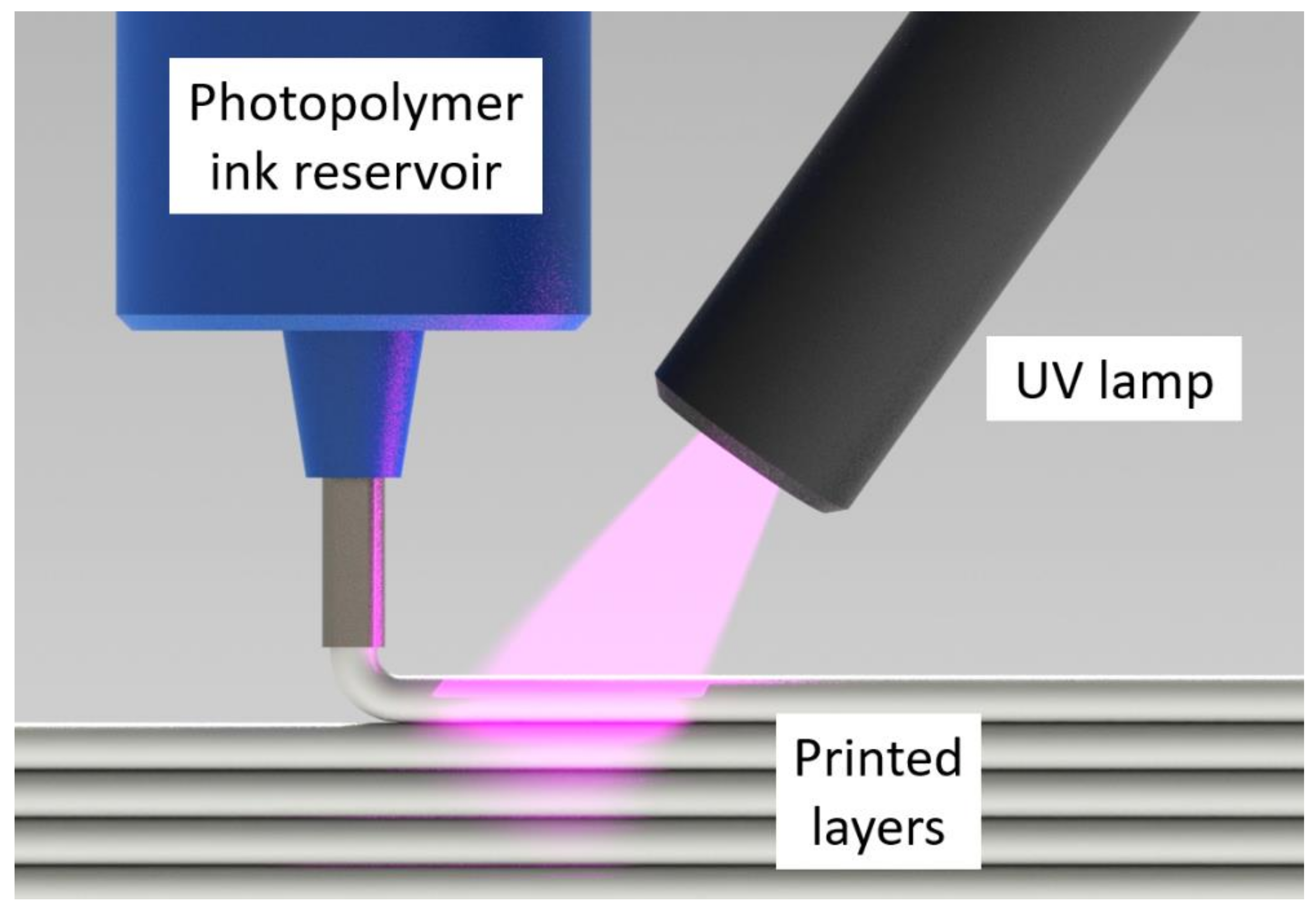

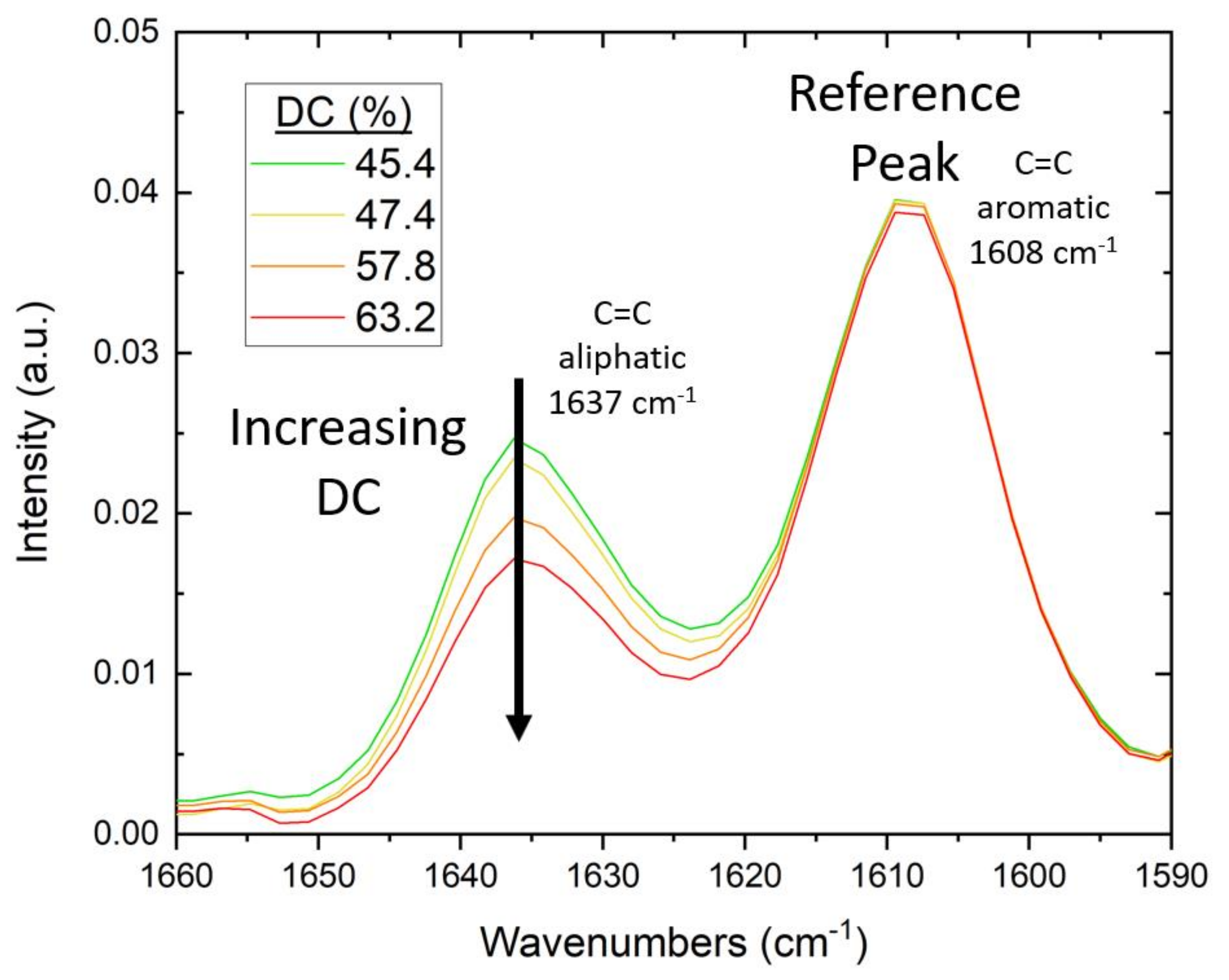



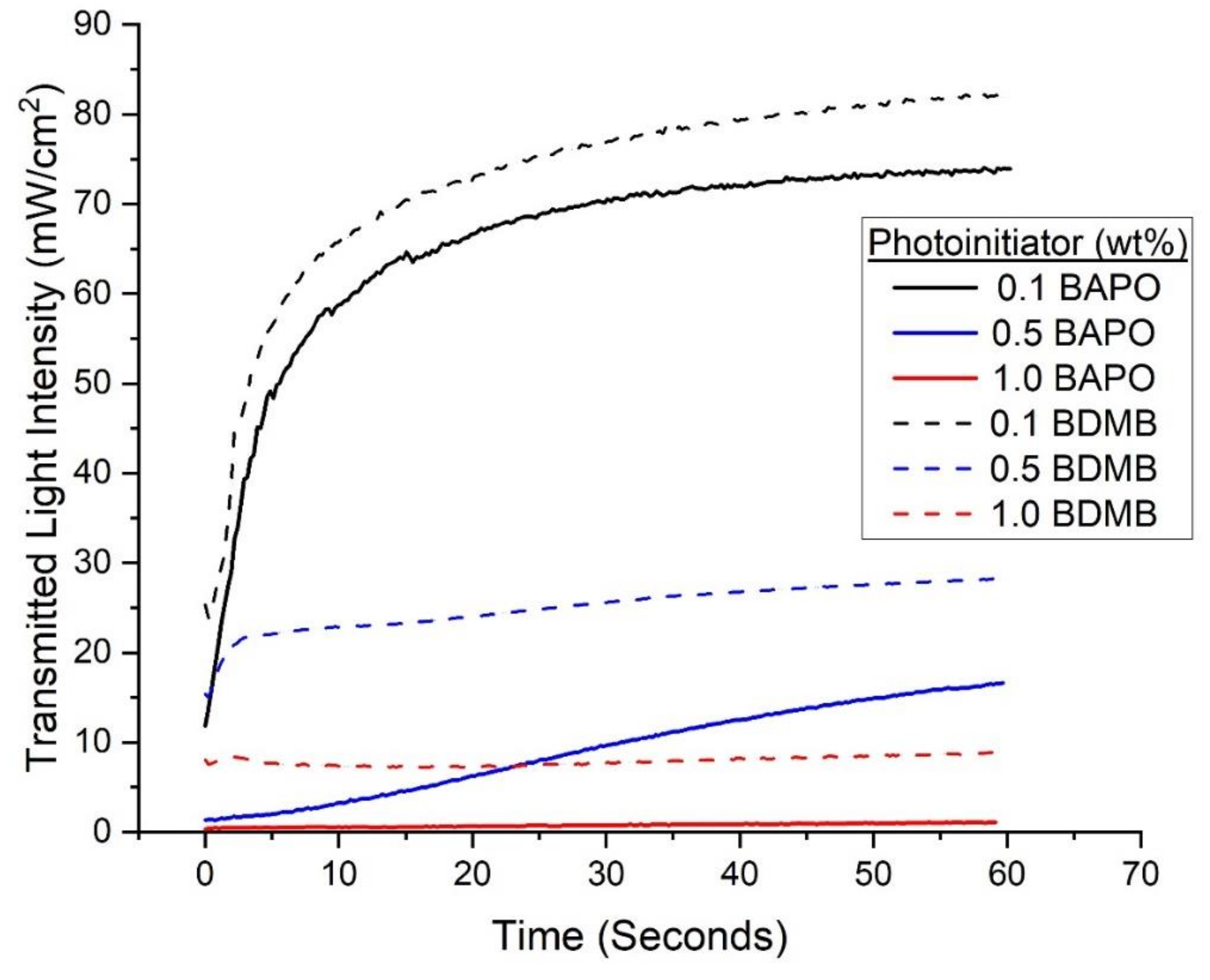

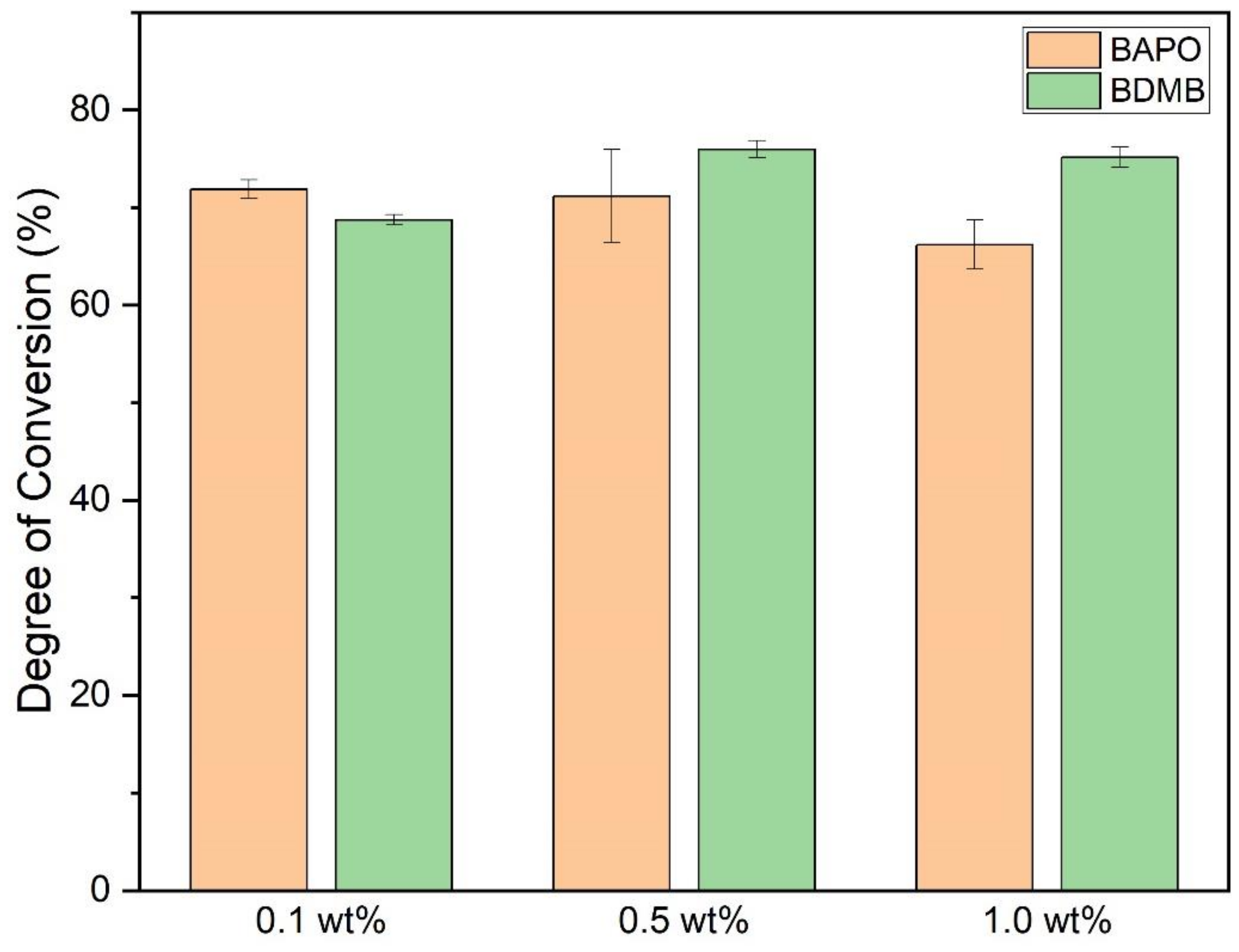
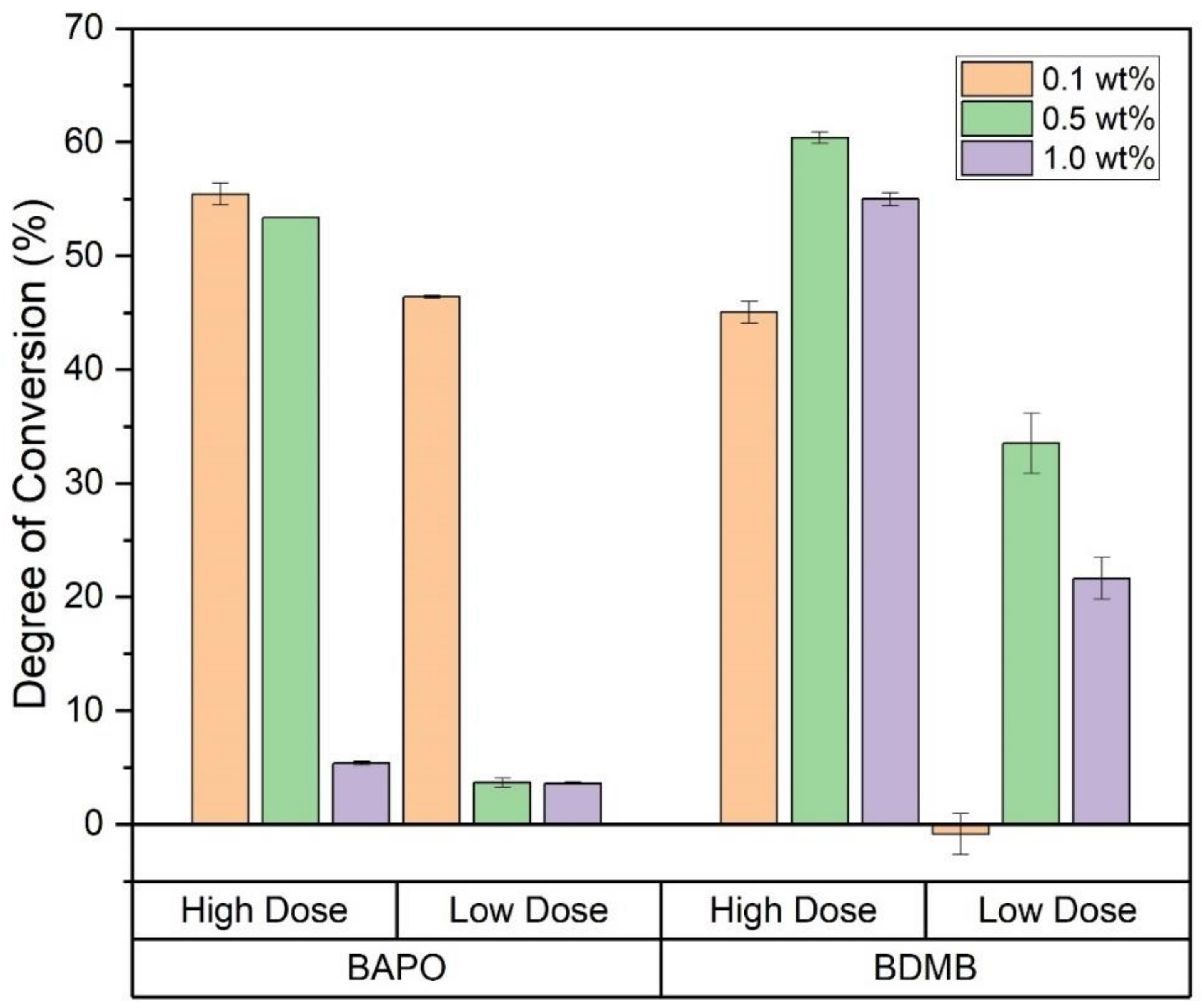
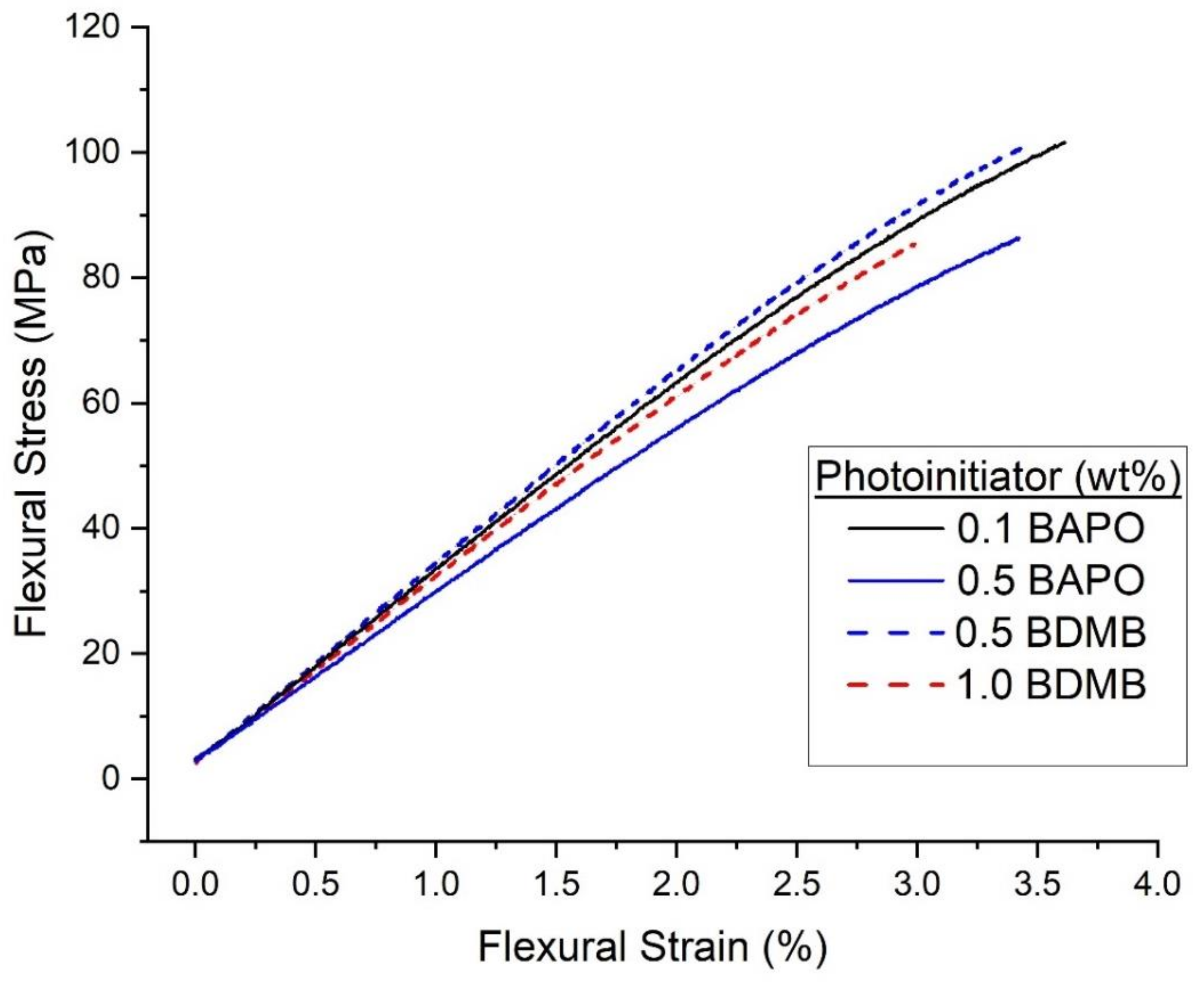

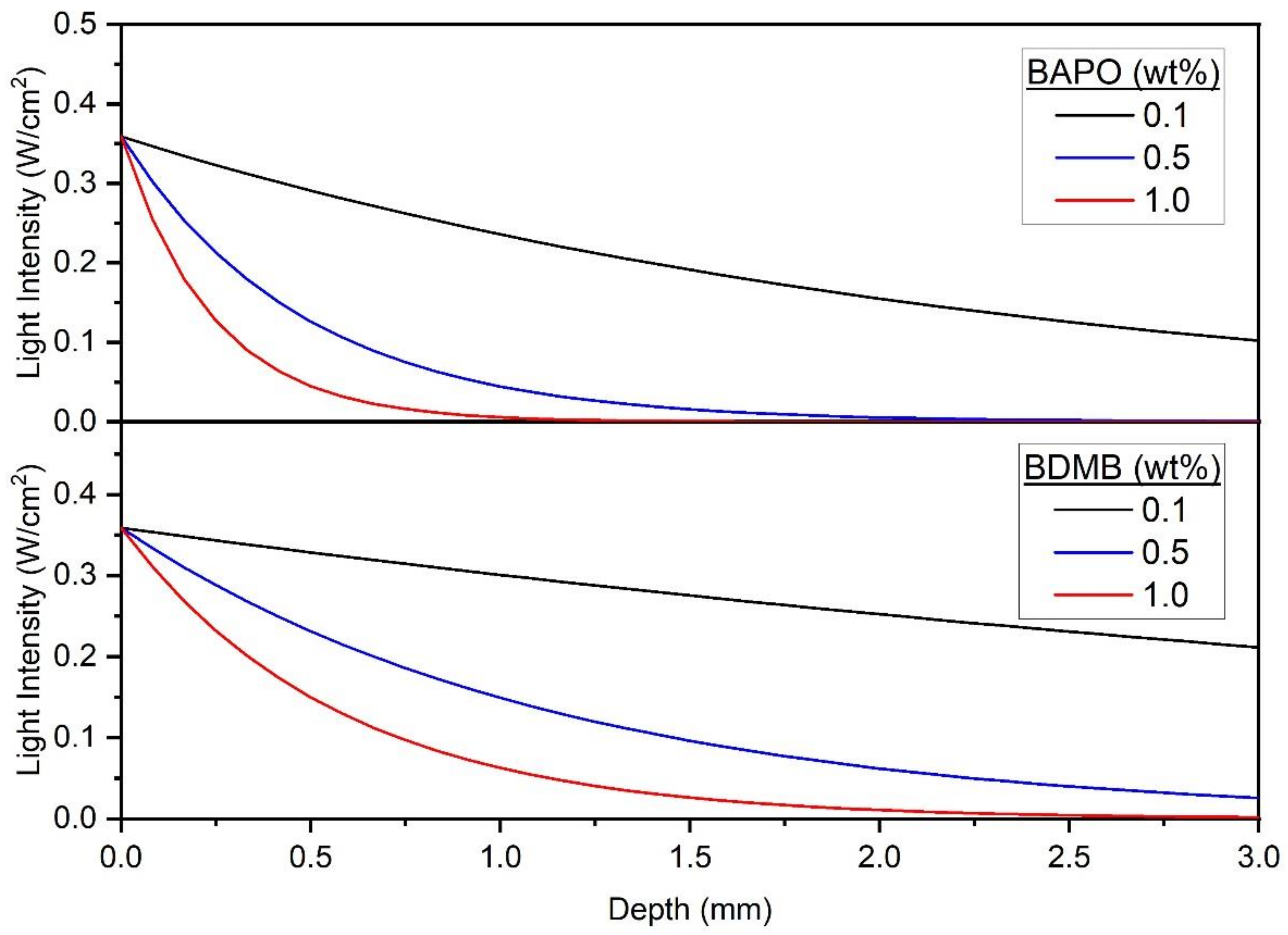
| BAPO | BDMB | |||
|---|---|---|---|---|
| 0.1 wt% | 0.5 wt% | 0.5 wt% | 1.0 wt% | |
| Flexural Strength (MPa) | 108.7 [11.2] | 94.6 [9.7] | 101.4 [10.1] | 95.4 [14.9] |
| Flexural Modulus (GPa) | 3.1 [0.0] | 2.7 [0.1] | 3.1 [0.1] | 2.9 [0.1] |
| Failure Strain (%) | 4.0 [0.8] | 4.1 [0.8] | 3.6 [0.6] | 3.7 [0.9] |
Publisher’s Note: MDPI stays neutral with regard to jurisdictional claims in published maps and institutional affiliations. |
© 2022 by the authors. Licensee MDPI, Basel, Switzerland. This article is an open access article distributed under the terms and conditions of the Creative Commons Attribution (CC BY) license (https://creativecommons.org/licenses/by/4.0/).
Share and Cite
Stiles, A.; Tison, T.-A.; Pruitt, L.; Vaidya, U. Photoinitiator Selection and Concentration in Photopolymer Formulations towards Large-Format Additive Manufacturing. Polymers 2022, 14, 2708. https://doi.org/10.3390/polym14132708
Stiles A, Tison T-A, Pruitt L, Vaidya U. Photoinitiator Selection and Concentration in Photopolymer Formulations towards Large-Format Additive Manufacturing. Polymers. 2022; 14(13):2708. https://doi.org/10.3390/polym14132708
Chicago/Turabian StyleStiles, Alex, Thomas-Allan Tison, Liam Pruitt, and Uday Vaidya. 2022. "Photoinitiator Selection and Concentration in Photopolymer Formulations towards Large-Format Additive Manufacturing" Polymers 14, no. 13: 2708. https://doi.org/10.3390/polym14132708
APA StyleStiles, A., Tison, T.-A., Pruitt, L., & Vaidya, U. (2022). Photoinitiator Selection and Concentration in Photopolymer Formulations towards Large-Format Additive Manufacturing. Polymers, 14(13), 2708. https://doi.org/10.3390/polym14132708







